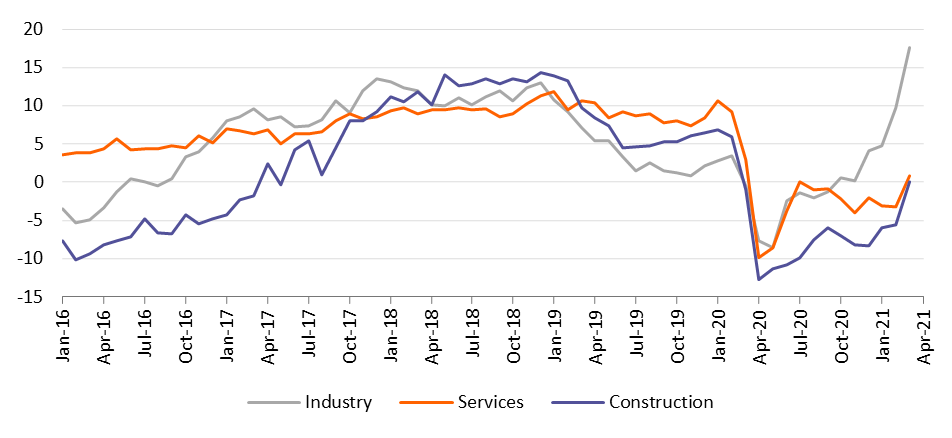Eurozone: Flip-flopping towards recovery
Economic sentiment in the eurozone is clearly improving, though new lockdown measures still point to a weak start to the second quarter. Pipeline inflationary pressures are increasing, but it is probably too soon to talk of a lasting trend
Third wave
The sight of tugboats trying to unstick the containership Ever Given in the Suez Canal is to some extent a metaphor for the difficulty in getting the eurozone recovery on a sustainable course. The issues are now well-known: a third wave of the pandemic has pushed several countries to tighten lockdown measures again or to extend them, jeopardising a reopening of the economy in April. Without a miraculous acceleration of the vaccination pace, not only will the skiing season and Easter holidays be lost, but a big part of summer tourism will be at risk, too.
The temporary blockage of the Suez Canal adds to ongoing supply disruptions
While the shipping delays prompted by the temporary blockage of the Suez Canal are not a game-changer, this certainly adds to the supply chain disruptions hurting some eurozone sectors. Fortunately, the large US fiscal stimulus will also have a positive impact on the eurozone economy (around 0.5ppt according to the OECD), but the domestic fiscal impulse is likely to soften over the coming year. Moreover, the German Constitutional Court ordered German President Frank-Walter Steinmeier to stop the ratification of the European Recovery Fund on the back of a complaint that the set-up of the fund conflicts with the German constitution. While we believe that the fund will still go ahead, chances are slim that Karlsruhe court will allow the fund to become permanent.
Second quarter recovery still likely
To be sure, the latest sentiment data is quite strong, though the surveys were taken before the announcement of new lockdown measures and might therefore paint too rosy a picture. However, the fact that order books are filling up definitely points to a recovery in the second quarter. We still think that some of the excess savings households accumulated will gradually be reinjected into the economy, boosting the recovery in the second half of the year.
That said, with the second quarter still negatively impacted by the pandemic and the slow vaccination pace, we have reduced our GDP growth forecast for 2021 from 3.8% to 3.6%, maintaining 3.5% for 2022.
Order books filling up

Pipeline price pressures
With strong international demand for goods and strained supply chains leading to increased prices for commodities, intermediate goods and transport, it doesn’t come as a surprise that selling price expectations in industry jumped in March to the highest level since 2011. But in construction, retail and even in the services sector, selling price expectations have also increased. So pipeline price pressures are becoming more important, especially in manufacturing.
At the same time, we believe that supply chains will normalise in the course of the year, once inventories have been replenished. Energy prices are also not expected to rise significantly further from today’s levels, given the important spare capacity. And it still seems too early to expect that a spike in inflation will immediately set in motion a price-wage spiral. The most recent wage agreement in Germany, one of the leading countries in terms of the recovery, actually remained rather subdued.
Expected selling prices survey

ECB remains supportive
The European Central Bank has already stated that it will look through the price increases this year and that the economy still needs support. For the time being, this support is focused on preventing a preliminary steepening of the yield curve. However, as the recovery takes hold, the ECB will reassess financial conditions. Board member Isabel Schnabel stated that as the economy recovers, real and nominal long-term rates will gradually rise in tandem with the real equilibrium rate, though this could not be considered monetary tightening. We stand by our conviction that some increase in bond yields is likely, with the German 10-year bund yield leaving negative territory within 12 months.
This publication has been prepared by ING solely for information purposes irrespective of a particular user's means, financial situation or investment objectives. The information does not constitute investment recommendation, and nor is it investment, legal or tax advice or an offer or solicitation to purchase or sell any financial instrument. Read more
Download
Download article
1 April 2021
April Economic Update: Bigger things than the Suez ship are still firmly stuck in the mud This bundle contains 13 Articles